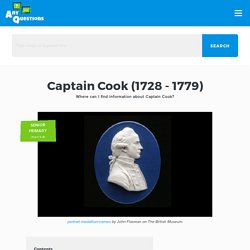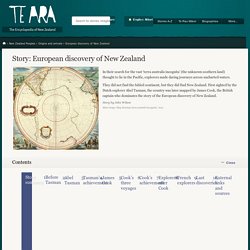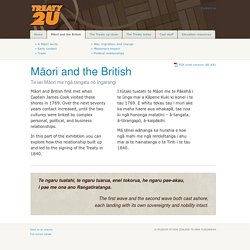

First encounters - Aotearoa History Show. In part three, Tasman and then Cook visit and before long Europeans come to stay.

Muskets, missionaries and international trade change the country as two cultures seek to make sense of each other. You can LISTEN to the audio only podcast Or WATCH a video version of the show! Topics covered Tasman’s voyage to Aotearoa/New Zealand and his interaction with Māori.James Cook’s voyages to Aotearoa/New Zealand. If you missed the start of the series, you can watch episode one here. Photo: RNZ/NZ On Air. First Encounters (New Zealand) 2019 marks 250 years since the first meetings between Māori and Europeans during James Cook and the Endeavour's 1769 voyage from England to Aotearoa (New Zealand).

This was not the first meeting. Dutch explorer Abel Janszoon Tasman sailed into Golden Bay in 1642 and had a brief, violent encounter with Māori in 1642. Whalers started visiting New Zealand from 1791 and were followed by other traders, early settlers and missionaries from 1800. From the time of first contact, Europeans had a major impact on Maori, their land, beliefs and culture and the technologies and tools available to them.
Māori history post-European arrival. First encounters. Captain Cook (1728 1779) Captain James Cook was an English sea captain and explorer.

He spent many years sailing around and mapping the South Pacific. He is credited with being one of the first Europeans to discover many countries and islands in the Pacific Ocean, including New Zealand. He actually came to New Zealand three times, each time improving detail on his maps. General Websites New Zealand History There is good biographical information and some good pics on this website.
There is an article about Captain Cook himself.If you put Captain Cook into the search bar, you will get lots of suggested information. Tips: A website's address (URL) can give you a hint about how reliable it is. Te Ara: The Encyclopedia of New Zealand This website is a really useful one and has very relevant and accurate information. European discovery of New Zealand. New Zealand had already been discovered by the time Europeans first saw the Pacific.

Polynesian navigators had reached New Zealand probably in the 13th century. Abel Tasman Portuguese and Spanish navigators sailed the Pacific Ocean in the 1500s, but it was probably not until 1642 that a European sighted New Zealand. In that year the Dutch explorer Abel Tasman sailed in search of a vast southern continent, which many Europeans thought might exist in the South Pacific. Dutch merchants hoped this land would offer new opportunities for trade.
Shortly afterwards, a Dutch map maker gave the name Nieuw Zeeland to the land Tasman had discovered. James Cook The English navigator Captain James Cook sighted New Zealand on 6 October 1769, and landed at Poverty Bay two days later. The naturalists Joseph Banks and Daniel Solander, who sailed with Cook, gathered a great deal of information about the country’s plants and animals. Encounters. South Seas - Voyaging and Cross-Cultural Encounters in the Pacific. Marking 250 years since Cook first visited NZ. School Journal Te Tiriti o Waitangi booklet. Māori and the British - TREATY 2 U. PDF print version (80 KB) Māori and British first met when Captain James Cook visited these shores in 1769.

Over the next seventy years contact increased, until the two cultures were linked by complex personal, political, and business relationships. In this part of the exhibition you can explore how this relationship built up and led to the signing of the Treaty in 1840. I tūtaki tuatahi te Māori me te Pākehā i te ūnga mai a Kāpene Kuki ki konei i te tau 1769. E whitu tekau tau i muri ake ka maha haere aua whakapā, tae noa ki ngā hononga matatini – ā-tangata, ā-tōrangapū, ā-kaipākihi. Mā tēnei wāhanga ka hurahia e koe ngā mahi me ngā rerekētanga i ahu mai ai te hainatanga o te Tiriti i te tau 1840.
Te ngaru tuatahi, te ngaru tuarua, enei tokorua, he ngaru pae-akau, i pae me ona ano Rangatiratanga. The first wave and the second wave both cast ashore, each landing with its own sovereignty and nobility intact.